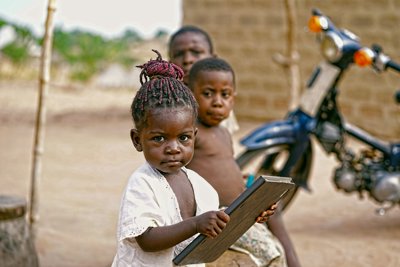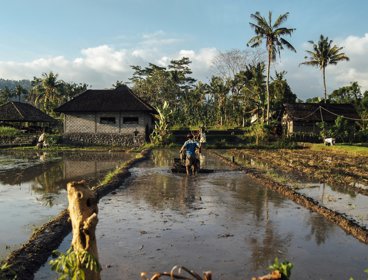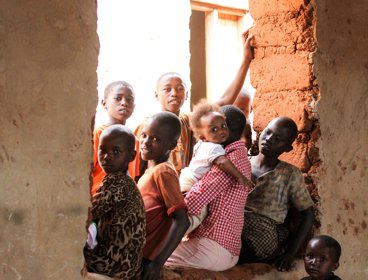Daniel Morchain is a Global Advisor for climate change adaption at Oxfam.
His work involves assessing vulnerabilities, risks and opportunities with rural communities all over the world. His work is especially connected to the impact of climate change and how one can build resistance and resilience to it within communities. We spoke to him about some of these challenges.
What is ‘resilience’ in the context of development issues and what forms does it take on the ground?
For a while now the humanitarian and development sector have adopted the term ‘resilience’. It means different things to different organisations because there is no physical law or equation that determines the resilience of people – unlike materials, where we might measure resilience as the point at which they break after bending.
In the humanitarian and development sector resilience often refers to the ability of people to not only subsist, but thrive even when faced with big challenges or shocks. That means, in part, that communities hit by a long drought in the Sahel, conflict in Syria, an earthquake in Chile or California, a flood in the UK, a death in the family or the loss of one’s job, would have the ability to absorb these shocks, reduce their negative impact, and successfully resume their previous, or start new, improved and more sustainable livelihood activities eventually in the aftermath. Resilience, in that sense, is about bouncing forward, and not just going back to the initial state – because initial states often entail a number of deficiencies.
Resilience is more than just building infrastructures to protect us from shocks: ‘soft’ or invisible structures such as education programmes also help us prepare and respond better to life’s challenges. It is about building a common understanding of what issues people are facing in a given place, the opportunities available to them and potential new ones, and - based on that - design development programmes that reflect the complexity of people’s lives, respond to their priorities and create opportunities for people to have a greater say in shaping their own future.
It is important to remember that resilience is not a fixed state either. With environmental, social and political situations changing constantly, building resilience is about adapting to these changing conditions and using resources sustainably, as well as gradually reducing development support in favour of increased self sufficiency and determination.
Where have resilience efforts already had a positive impact?
In the island of Mindanao, in the Philippines, resilience thinking is no straightforward task. It requires addressing a number of challenges at the same time to support people’s development efforts. These include regular typhoon landfalls, environmental and land degradation resulting from mining and other factors, climate change impacts like floods, drought and increasing temperatures, governance shortcomings in terms of e.g. access to land, agricultural inputs and market information, and conflict and displacement resulting from tension and fights between government forces and insurgent Bangsamoro groups supporting increased autonomy for this region. Despite its complexity, resilience efforts are showing results as development programmes increasingly incorporate short and long term components and become multi-sector approaches (addressing more than one issue simultaneously).
For example, we are running climate resilient farming schools at community level, where on one hand indigenous knowledge (the expert knowledge people have accumulated over generations by adapting their crops and practices to the local circumstances) is recovered and disseminated, and on the other hand technologies are introduced (such as System of Rice Intensification) and newly developed crop varieties are introduced in experimental plots. In parallel, we work with the national meteorological office to produce locally relevant weather forecasts that help small scale farmers make decisions – and we are making efforts now to collaboratively produce longer forecasts and use historical data to inform seasonal decision making by farmers. Furthermore, we also produce risk assessments with communities that lead to disaster risk reduction plans. These plans are produced in collaboration with municipal authorities, and in that way throughout the process we identify governance shortcomings that need to be addressed. Another component of the work in Mindanao is women's empowerment and fostering opportunities for women to have a larger and more recognised role in livelihood activities and in conflict resolution.
Another example of resilience building from the Philippines is evidenced in the aftermath of Typhoon Haiyan, which hit the central region of the Philippines in November 2013. Humanitarian and development efforts started to focus on long-term reconstruction and the promotion of sustainable livelihood activities shortly after the disaster, for instance through joint discussions about medium term planning between humanitarian-development sectors, communities and government.
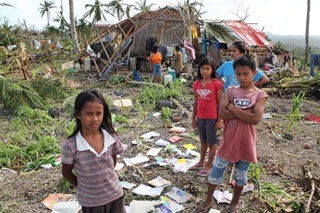
“There used to be a school here…” Residents of Cebu island, Philippines after Typhoon Haiyan. Source: Flickr Creative Commons User European Commission DG ECHO
Previously, a lot of development work by NGOs has focused on reducing the impact of potential environmental and humanitarian disasters. Is resilience planning a move away from this?
Not at all. With the recent emphasis on resilience thinking, development work continues to address issues such as cyclones in South Asia or droughts in Central America and the Sahel, both in helping people to prepare and respond to crises (humanitarian support) and, equally importantly, by addressing the underlying issues that make billions of people vulnerable to these hazards. This ‘development support’ is comprehensive in scale. For example for people dependent on agriculture for their livelihoods it includes things like working with small scale farmers to diversify their production, growing types of vegetables that are more tolerant to dry periods, connecting farmers to markets so that they can have extra income, making seasonal weather forecasts available to farmers (as one of the tools for decision making) so that they can plan better and reduce their risk, establishing farmer field schools to capture and disseminate local knowledge as well as to introduce and co-develop new practices. The added-value that resilience brings is that it links humanitarian and development efforts so that they are pursued together and so when the next typhoon, flood, or drought hits, people are more prepared to face them and will not be pushed back again to square one.
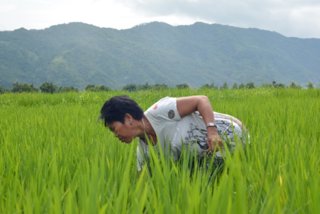
Rice farming in the Philippines. Source: Daniel Morchain, Oxfam
What role does scale play in discussions about resilience? Should resilience efforts only target localised problems and short term needs?
A resilient person, community or country relies on a number of properly functioning services, institutions and personal/family skills and connections (social capital). Such a structure influences the capacity of someone to be able to constructively respond to changes, and not be overwhelmed and drown when something out of the ordinary happens. Even if in some cases development is tackled by addressing very localised problems, the ultimate aim is to identify and promote the conditions that are needed for other actors – the national governments, definitely, but also a wide range of stakeholders – to apply these solutions, or incentivise their application by others (examples: insurance, social protection schemes, online services to make goods available in remote locations, entrepreneurship skills, care related services).
While problems are perceived completely differently by people depending on a number of factors, there are ‘resilience characteristics’ that affect us all. Identifying and building the components of these characteristics is often trialed at the community level, ensuring that the poorer and most vulnerable people have the opportunity to access them. The challenge for development actors and governments is to find the mechanisms to make these opportunities available for people across the country, and to build a platform where the unusual suspects (like the private sector) will also find an argument to participate with and co-create a win-win approach for them and for communities.
Likewise, global drivers such as climate change, deforestation, biodiversity loss and rapid rates of urbanisation, all have direct impacts on people’s efforts to build their own resilience – especially those of impoverished and marginalised groups.
How do communities in need react to planning for resilience rather than hard engineering solutions which may be seen as more secure?
It may be tempting to think that infrastructure solutions can bring a quick win for communities, but often these solutions are not as long lasting or inclusive as those which build social capital and improve governance systems. If a ‘solution’ is just flown-in and is not accompanied by a shared understanding among users and interested parties, it may stop being a solution soon after it’s implemented, and even be the source of problems or conflict. For example in Niger, over-extraction of groundwater may lead to the inoperability of a newly dug borehole if, for instance, no community-led monitoring system is installed, and it can lead to unfair access to water if access rights are not thoroughly addressed among the community groups.
In terms of working with communities on ‘soft’ rather than ‘hard’ or tangible solutions, what is most important is to develop a long term vision. Behavioural change, skills development or women's rights and women empowerment does not happen in two weeks, or two months. So, one-off training sessions, in my opinion, do not really create the conditions for change, even if people are willing. So, development actors need to ensure that there is commitment among actors, such as local NGOs, district planning officers, research institutions, private sector and communities themselves, to work toward community development in the mid-long term – and this is most likely to happen when everyone sees the benefit of doing so: better planning across local, district and national levels, stable agricultural production linked to markets, women-led cooperatives and training groups.
What role do women play in community resilience programmes?
In my opinion, women need to play a greater role in planning in general. While there are significant efforts from women themselves and from development actors to give women a more just role within these processes, much remains to be done. This comes not just out of a women’s rights perspective, but also because women play a major role in the care-related and the productive side of the household economy, such as food production. In other words, there is an ethical, but also an economic case to provide more equal rights to women in agriculture (which they do not have at the moment). Enhancing women’s access to land, credit, training would result in considerable increases in global food production and have a big impact in poverty reduction.
Secondly, women have a tremendous potential to contribute to overcoming developmental challenges, such as by actively taking on roles where their contribution offers an added value to men’s – for instance, in disaster preparedness activities and in conflict resolution.
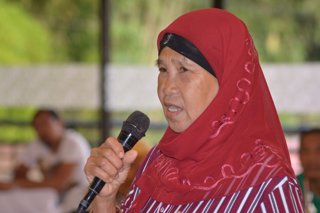
The inclusion of women in debates, Mindanao, Philippines
Source: Dante Dalabajan, Oxfam
In a world of great uncertainty, how is it possible for a ‘plan for resilience’ to be implemented successfully?
There are two main points here. Firstly, one should develop a good understanding of the main issues and hazards that affect the communities with whom one’s working, as well as how relevant social groups and livelihood activities can be affected by these issues. One way we to do this is through the Vulnerability and Risk Assessment methodology (VRA), which supports the identification of these issues and hazards, and their impact on community groups. It then goes on to develop a broad understanding of the impact of each hazard for the community (for example when households lose their agricultural production, this may force the migration of one or two parents to urban centres for wage work, and leave the children behind without the necessary care or out of school, as well as create problems between the couple, potentially leading to their separation) and, together with local and regional stakeholders, collaboratively develop risk reduction and resilience building measures for the community.
Secondly, one should recognise that we live in a world that is uncertain, and therefore encourage flexibility in development planning and institutions. The objectives of a development plan will almost certainly change as the context evolves, as political aspects change, as new technologies are developed and as climate change impacts are felt. A flexible plan will be able to adapt to its environment, and more importantly, it will focus on building people’s skills, institutions’ scopes, social capital within communities and their capacity to adapt to changes and innovate.
One should also consider ownership and accountability. Communities and local authorities need to feel that they are well represented and are active participants in these plans; that the plans address their priorities and lead to their empowerment and to opportunities. Likewise, it is important that mechanisms exist to hold actors at every level accountable for their role in these plans.
What are the other main obstacles to resilience planning in vulnerable communities?
There are many. Short term thinking, narrow focus and changing priorities of donors and governments (although changes for the better are happening). It is challenging to maintain structures and institutions beyond the duration of projects, as well as their original function (for example small scale farmers’ cooperatives can become increasingly led by the better-off members who block new entrants after the initiating donor exits). It is difficult for impoverished communities to plan for the mid to long term when short term needs are not being met.
Securing long term political commitment and ensuring fair, secure and long term access to natural resources (such as land and water) and markets is a common obstacle, particularly so for women and for the poorer strata of societies. I could go on: water availability and quality; deforestation and land degradation; climate change impacts; conflict…
While it is a long list, we should not forget that there is an equally long one to describe the opportunities for building resilience, and I would start it with this one: people’s potential and will to grow.
Key Words
Adaptation
The action associated with changing ones behaviour to better cope with the demands of changing natural phenomena.
Hard engineering
Measures taken to prevent the impact of a natural hazard or phenomenon by means of physical structures and changes to the landscape.
Humanitarian Aid
A description for those organisations acting with the needs of the person at the core of their work, such as providing materials or logistical assistance to those in need.
Infrastructure
The services and facilities needed for an economy to function, for example transport networks, energy supply and health care.
Mitigation
The action of accepting that natural hazards or natural phenomena are going to happen and adapting one's life and home to cope with those changes rather than prevent them.
Non-Government Organisation (NGO)
An organisation or body that operates in a not-for-profit and apolitical fashion.
Resilience
The ability to reduce the loss experienced from a natural hazard or natural phenomena, or to return to an original state more quickly by having measures in place that allow individuals and communities to adapt to their changing circumstances.
Risk
The likelihood of suffering adverse effects from a hazard
Soft Engineering
Measures taken to prevent the impact of a natural hazard or phenomenon by means of non-physical structures, such as education programmes or designed social changes.
Vulnerability
The changing state by which one judges how likely a community or individual is to experience loss as a result of a natural hazard, climate change or other phenomenon.
Lesson Ideas
Students can think about the different components needed to make a community resilient to climate change and/or an increase in associated natural hazards. Comparing the UK, or a similar developed country and the Philippines, students can ‘traffic light’ those ideas – red for near impossible, yellow for possible but with considerable time or financial investment needed and green for actionable with few obstacles faced.
With further research into the causes and consequences of Typhoon Haiyan in the Philippines, students can create a ‘road map’ to resilience in the form of a graphical flow diagram. Students can explore how, in the process of recovering from the disaster, Tacloban can rebuild, both through hard and soft engineering, in such a way that they are more resilient to the next typhoon.
Using a variety of country examples (that themselves experience a variety of different natural hazards) students can create a vulnerability spectrum from most to least vulnerable. Comparing this to a scale of each country’s GDP per capita (or similar development indicator) students can examine links between vulnerability and development. Alternatively students might recognise that development level is only one part of vulnerability and suggest other factors for consideration.
Links
Daniel was interviewed in December 2014.
